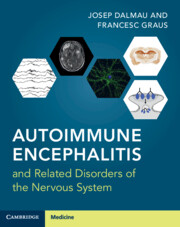Book contents
- Autoimmune Encephalitis and Related Disorders of the Nervous System
- Autoimmune Encephalitis and Related Disorders of the Nervous System
- Copyright page
- Dedication
- Contents
- Clinical Vignettes
- Videos
- Preface
- Abbreviations
- Section 1 Overview
- Section 2 Antibodies and Antigens
- Section 3 Specific Syndromes and Diseases
- Section 4 Autoimmunity in Neurological and Psychiatric Diseases
- Chapter 19 Autoimmune Psychosis
- Chapter 20 Psychiatric Manifestations of Autoimmune Encephalitis
- Chapter 21 Abnormal Movements in Neurological Autoimmune Disorders
- Chapter 22 Sleep and Autoimmunity
- Chapter 23 Immunity, Inflammation, and Epilepsy
- Chapter 24 Autoimmune Dementia: A Useful Term?
- Chapter 25 Frequently Asked Questions on Autoimmune Encephalitis and Related Disorders
- Index
- References
Chapter 23 - Immunity, Inflammation, and Epilepsy
from Section 4 - Autoimmunity in Neurological and Psychiatric Diseases
Published online by Cambridge University Press: 27 January 2022
- Autoimmune Encephalitis and Related Disorders of the Nervous System
- Autoimmune Encephalitis and Related Disorders of the Nervous System
- Copyright page
- Dedication
- Contents
- Clinical Vignettes
- Videos
- Preface
- Abbreviations
- Section 1 Overview
- Section 2 Antibodies and Antigens
- Section 3 Specific Syndromes and Diseases
- Section 4 Autoimmunity in Neurological and Psychiatric Diseases
- Chapter 19 Autoimmune Psychosis
- Chapter 20 Psychiatric Manifestations of Autoimmune Encephalitis
- Chapter 21 Abnormal Movements in Neurological Autoimmune Disorders
- Chapter 22 Sleep and Autoimmunity
- Chapter 23 Immunity, Inflammation, and Epilepsy
- Chapter 24 Autoimmune Dementia: A Useful Term?
- Chapter 25 Frequently Asked Questions on Autoimmune Encephalitis and Related Disorders
- Index
- References
Summary
In this chapter we review the inflammatory mechanisms involved in epileptogenesis, the caveats and limitations of the term autoimmune epilepsy, and two epileptic syndromes of autoimmune origin: epilepsy associated with GAD antibodies and Rasmussen encephalitis. The International League Against Epilepsy (ILAE) recently proposed the definition of acute symptomatic seizures secondary to autoimmune encephalitis for the seizures that occur in the setting of the active phase of immune-mediated encephalitis. In contrast, the term autoimmune epilepsy applies to chronic seizures considered to be secondary to autoimmune brain diseases. If promptly diagnosed and treated, patients with symptomatic seizures due to antibody-mediated encephalitis rarely evolve to develop epilepsy and, therefore, they do not fulfil criteria of autoimmune epilepsy. Scoring systems to predict autoimmune seizures are not very useful because they rely on the presence of additional neurological manifestations or diagnostic tests included in the definition of autoimmune encephalitis. Antibodies against neuronal surface antigens occur in a minority (<5%) of patients with isolated epilepsy; the significance of these antibodies is unclear as the spectrum of symptoms of these patients is not different from that of seronegative cases. In contrast, antibodies against GAD (an intracellular protein) occur in a small subset of patients with temporal lobe epilepsy that is usually refractory to anti-seizure medication.
Keywords
- Type
- Chapter
- Information
- Publisher: Cambridge University PressPrint publication year: 2022

